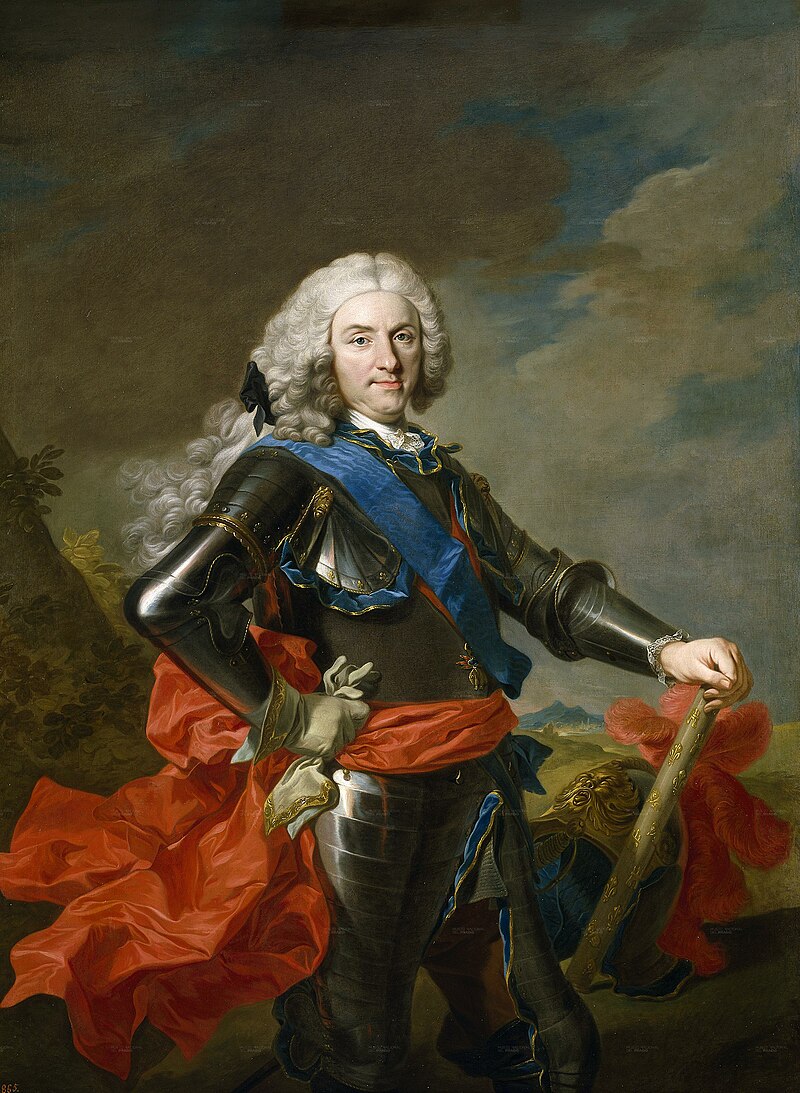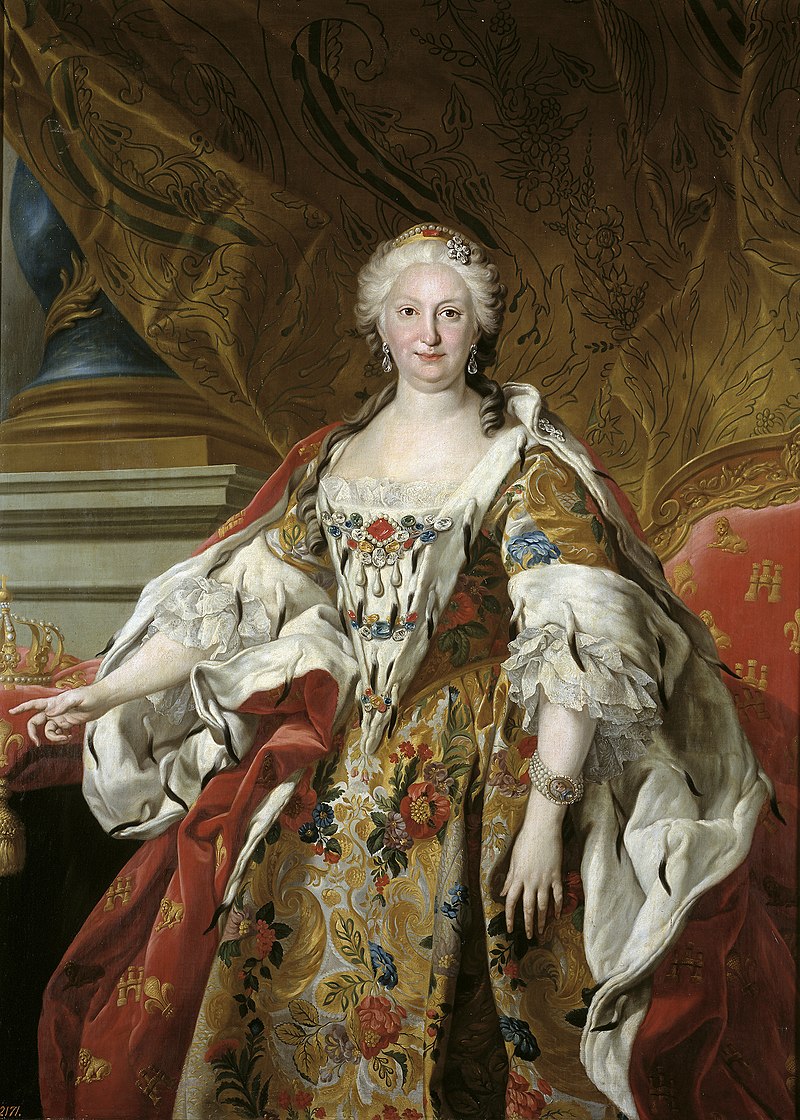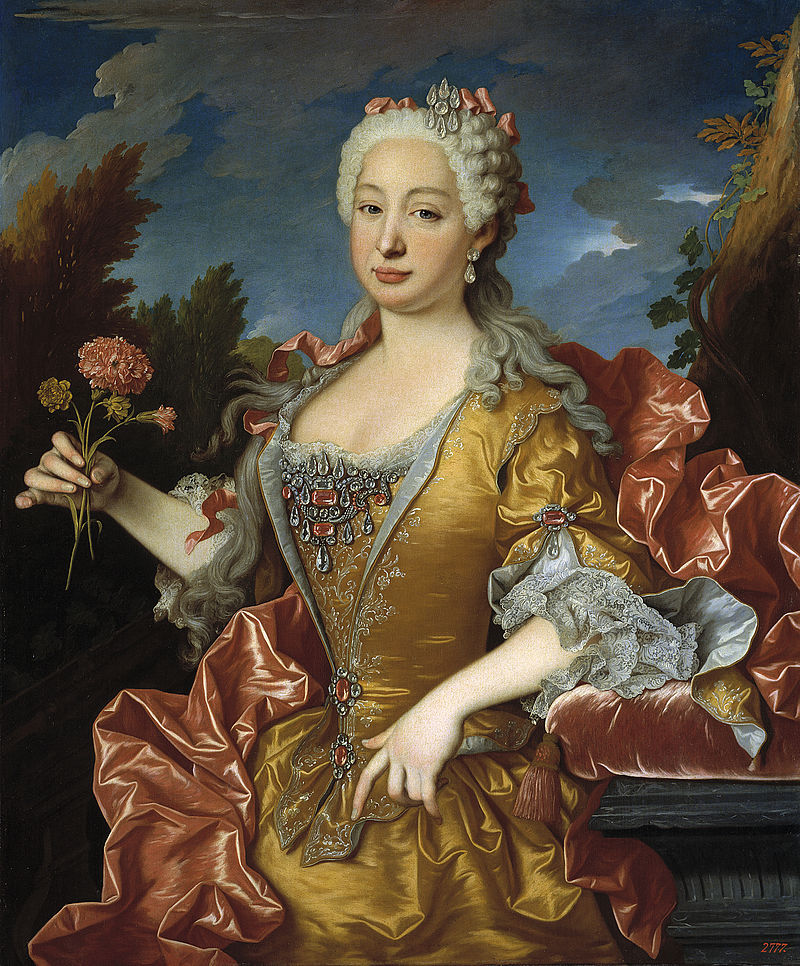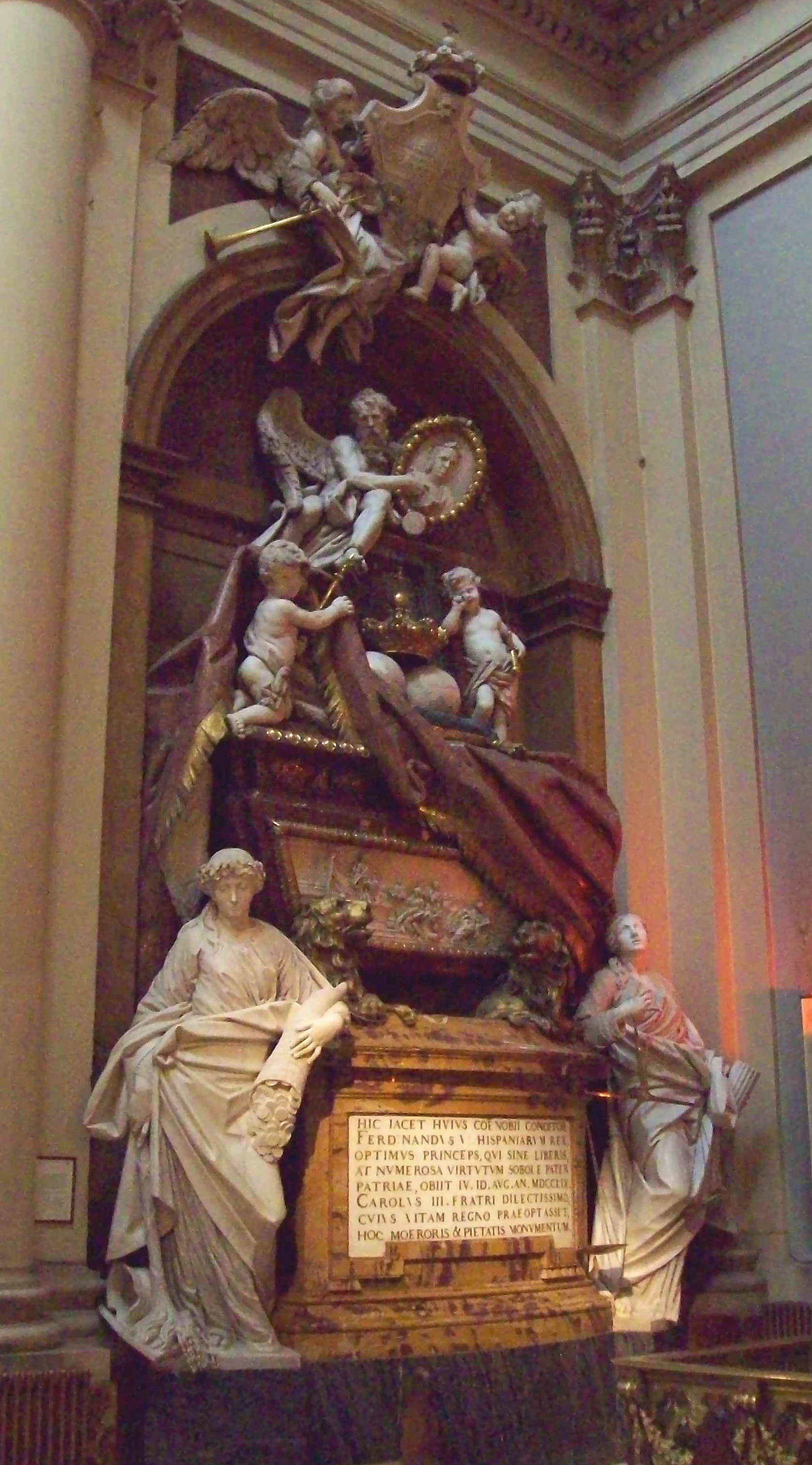by Susan Flantzer
© Unofficial Royalty 2023

Fernando VI, King of Spain; Credit – Wikipedia
Born on September 23, 1713, at the Royal Alcazar of Madrid in Madrid, Spain, Fernando VI was not expected to become King of Spain. He was the youngest of the four sons of Felipe V, King of Spain and his first wife Maria Luisa of Savoy. Fernando’s paternal grandparents were Louis, Le Grand Dauphin, the heir apparent to the throne of France, and Maria Anna Victoria of Bavaria. His maternal grandparents were Vittorio Amedeo II, King of Sardinia and Anne Marie of Orléans.

Fernando’s father King Felipe V of Spain, born a Prince of France; Credit – Wikipedia
Fernando’s father had been born a French prince, Philippe, Duke of Anjou, the second son of Louis, Le Grand Dauphin, the son and heir apparent of King Louis XIV of France. In 1700, King Carlos II of Spain, from the House of Habsburg, died childless with no immediate Habsburg heir. Louis, Le Grand Dauphin had the strongest genealogical claim to the Spanish throne because his mother Maria Theresa, Infanta of Spain had been the half-sister of Carlos II. However, neither Louis, Le Grand Dauphin nor his elder son Louis, Duke of Burgundy, Le Petit Dauphin could be displaced from their place in the succession to the French throne. Therefore, King Carlos II of Spain, in his will, named the second son of Louis, Le Grand Dauphin, 16-year-old Philippe, Duke of Anjou, as his successor. He reigned as Felipe V, King of Spain, the first Bourbon monarch of Spain.
Fernando had three older brothers but only his eldest brother Luis I, King of Spain, survived to his teenage years. Luis I died from smallpox at age seventeen.
- Luis I, King of Spain (1707 – 1724), married Louise Élisabeth of Orléans, no children
- Felipe, Infante of Spain (born and died 1709)
- Felipe, Infante of Spain (1712 – 1719)

Fernando’s stepmother Elisabeth Farnese of Parma; Credit – Wikipedia
Five months after his birth, Fernando’s mother Maria Luisa died from tuberculosis at the age of 25 on February 14, 1714. On December 24, 1714, ten months after the death of his mother, Fernando’s father married again to Elisabeth Farnese of Parma, the only surviving child of Odoardo Farnese, Hereditary Prince of Parma and Dorothea Sophie of Neuburg.

Felipe V of Spain with his second wife Elisabeth and some of his children from his first and second marriages – from left to right: the future Fernando VI, King Felipe V, the future Luis I; Felipe, the future Duke of Parma, Queen Elisabeth, a portrait of the Infanta Mariana Victoria, and the future Carlos III: Credit – Wikipedia
Fernando had six half-siblings from his father’s second marriage:
- Carlos III, King of Spain (1716 – 1788), married Maria Amalia of Saxony, had thirteen children including Carlos IV, King of Spain
- Mariana Victoria, Infanta of Spain (1718 – 1781), married José I, King of Portugal, had four daughters
- Felipe, Infante of Spain, Duke of Parma (1720 – 1765), married Louise Élisabeth of France, founder of the House of Bourbon-Parma, had three children
- Maria Theresa Rafaela, Infanta of Spain (1726 – 1746), married Louis, Dauphin of France, had one daughter who did not survive childhood, Maria Theresa Rafaela died in childbirth
- Louis, Count of Chinchón (1727 – 1785), Archbishop of Toledo, Primate of Spain and Cardinal, renounced his ecclesiastical titles, married morganatically María Teresa de Vallabriga, had four children
- Maria Antonietta Fernanda, Infanta of Spain (1729 – 1785), married Vittorio Amadeo III, King of Sardinia, had twelve children

Fernando at the age of ten; Credit – Wikipedia
In 1721, 8-year-old Fernando was given his own household supervised by Agustín Fernández de Velasco y Bracamonte, Count de Salazar, who was given the title of Governor and was responsible for Fernando’s upbringing and education. Felipe V’s second wife Elisabeth Farnese of Parma never showed affection toward her two stepsons. She considered her stepsons to be obstacles to achieving her main objective: to provide her sons with a realm to rule. Fernando had a lonely childhood, far from court, accompanied only by his older brother Luis.

Fernando’s brother King Luis I of Spain; Credit – Wikipedia
On January 14, 1724, Fernando’s father King Felipe V abdicated the Spanish throne in favor of his eldest son Luis for reasons that are still unclear. Perhaps it was because Felipe V suffered from mental instability and did not wish to reign due to his increasing mental decline. Another theory is that Felipe was concerned about the succession to the French throne due to several deaths. Although the treaty that ended the War of the Spanish Succession forbade a union of the French and Spanish crowns, perhaps Felipe hoped that by abdicating the Spanish throne, he could succeed to the French throne if necessary. However, the reign of Luis I, King of Spain lasted only until August 31, 1724, when Luis died from smallpox. Fernando’s father Felipe V was forced to once again ascend to the Spanish throne because 10-year-old Fernando was not yet of legal age. Fernando’s stepmother Elisabeth kept him away from inner court circles even after the death of his brother Luis. Although Fernando was heir to the throne and held the heir’s title Prince of Asturias, he was not allowed to participate in the Spanish Council of State and was not able to gain any experience in government work that would have prepared him for taking the throne.

Fernando’s wife Barbara of Portugal in 1729, the year of their marriage; Credit – Wikipedia
To strengthen an alliance with Portugal, a double marriage between Spain and Portugal was arranged between Fernando and Barbara of Portugal, daughter of João V, King of Portugal, and Fernando’s half-sister Mariana Victoria and the future José I, King of Portugal, King João V’s heir. In a complex and protocol-filled arrangement called the Exchange of Princesses, on January 19, 1729, the two sets of princes and princesses were escorted to the Portugal-Spain border by the two royal courts, and the princesses were exchanged in a richly decorated wooden pavilion built on a bridge over the Caia River that linked the towns of Elvas, Portugal and Badajoz, Spain. Then, both couples were married in richly decorated pavilions on the same day on the grooms’ sides of the Caia River. Fernando and Barbara had no children except a stillborn son in 1733.

A contemporary engraving depicting the Exchange of the Princesses over the Caia River on the Portugal-Spain border; Credit – Wikipedia
As Fernando’s father King Felipe V grew older, his mental issues worsened and his second wife Queen Elisabeth became the de facto ruler of Spain. Fernando and Barbara continually had to deal with Elisabeth’s animosity who wanted to keep her stepson away from court. From 1733 until 1737, they were kept more or less under house arrest in their apartments, prevented from appearing in public, and watched by the spies of Queen Elisabeth, until Barbara’s father King João V of Portugal intervened.
Felipe V, King of Spain died of a stroke at the age of 62 on July 9, 1746, and Fernando succeeded to the Spanish throne. Fernando VI, King of Spain reigned for thirteen years. Benevolent but weak, Fernando VI left the government mostly to others. After Fernando became king, he allowed his stepmother Elisabeth to stay in Spain. However, she had to move out of the Royal Palace of Buen Retiro in Madrid and into the Royal Palace of La Granja de San Ildefonso, known as La Granja. Those responsible for the government under Fernando VI set out to restore state finances and reform the country. Fernando VI, in contrast to his father and stepmother, pursued no personal or family interests in foreign policy. His reign was peaceful because he avoided involving Spain in any European conflicts.

Allegory of Fernando VI as a peaceful king by Antonio González Ruiz, 1754; Credit – Wikipedia
Fernando VI’s wife Barbara suffered from severe asthma for most of her life and became obese in the years before her death. On August 27, 1758, at the age of 46, Barbara died at the Royal Palace of Aranjuez, on the outskirts of Madrid, Spain. She was buried in the Church of Saint Barbara at the Convent of the Salesas Reales in Madrid, Spain which she had founded in 1748 as a school and home for young noblewomen.

Barbara of Portugal, Queen of Spain shortly before her death; Credit – Wikipedia
Barbara’s death broke Fernando’s heart. During the last year of his reign, probably at least partially caused by his wife’s death, Fernando VI rapidly lost his mental capacity and was held at the Castle of Villaviciosa de Odón, near Madrid, where he died less than a year after Barbara’s death, on August 10, 1759, as the age of 45. He was buried with his wife Barbara in the Church of Saint Barbara at the Convent of the Salesas Reales in Madrid.

Tomb of King Fernando VI of Spain; Credit – Wikipedia
Fernando VI’s marriage to Barbara of Portugal was childless and when he died, the elder surviving son of father King Felipe V of Spain and his stepmother Elisabeth Farnese of Parma succeeded his half-brother as King Carlos III of Spain. Elisabeth’s younger son Felipe had become sovereign Duke of Parma and founder of the House of Bourbon-Parma, and so Elisabeth achieved her goal of providing her sons with a realm to rule. All subsequent monarchs of Spain from the House of Bourbon are descendants of King Carlos III of Spain. Therefore, Elisabeth is the ancestor of the House of Bourbon that still reigns in Spain. Although the House of Bourbon-Parma no longer reigns, the pretender to the throne of the Duchy of Parma is Elisabeth’s descendant.
This article is the intellectual property of Unofficial Royalty and is NOT TO BE COPIED, EDITED, OR POSTED IN ANY FORM ON ANOTHER WEBSITE under any circumstances. It is permissible to use a link that directs to Unofficial Royalty.
Works Cited
- Bárbara de Braganza (2022) Wikipedia (Spanish). Wikimedia Foundation. Available at: https://es.wikipedia.org/wiki/B%C3%A1rbara_de_Braganza (Accessed: November 26, 2022).
- Fernando VI de España (2022) Wikipedia (Spanish). Wikimedia Foundation. Available at: https://es.wikipedia.org/wiki/Fernando_VI_de_Espa%C3%B1a (Accessed: November 26, 2022).
- Ferdinand VI of Spain (2022) Wikipedia. Wikimedia Foundation. Available at: https://en.wikipedia.org/wiki/Ferdinand_VI_of_Spain (Accessed: November 26, 2022).
- Flantzer, Susan. (2022) Elisabeth Farnese of Parma, Queen of Spain, Unofficial Royalty. Available at: https://www.unofficialroyalty.com/elisabeth-farnese-of-parma-queen-of-spain/ (Accessed: November 26, 2022).
- Flantzer, Susan. (2019) Felipe V, King of Spain, Unofficial Royalty. Available at: https://www.unofficialroyalty.com/felipe-v-first-bourbon-king-of-spain/ (Accessed: November 26, 2022).
- Maria Bárbara de Bragança, Rainha de Espanha (2022) Wikipedia (Portuguese). Wikimedia Foundation. Available at: https://pt.wikipedia.org/wiki/Maria_B%C3%A1rbara_de_Bragan%C3%A7a,_Rainha_de_Espanha (Accessed: November 26, 2022).
